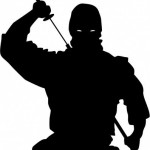Shu – Ha – Ri
(Protect-Break-Leave behind)
During your training in Budo Taijutsu, you will transition through many stages. Along this path, you will have to overcome many obstacles that hinder your progress. Many students wonder about what to concentrate on, or what is right or wrong at each of these stages. They see us training on the kihon happo, and various henka, and ask me “what is right?” The answer is shu – ha – ri.
To grasp the principles contained in shu – ha – ri, you must start at shu(Protect).
Shu (Protect)
In “protecting” one’s art, and at the simplest of understanding, each of us, have to start with the fundamentals of our art, and practice them diligently. There is no need to forget them, in fact you must master them for a true understanding of that which you practice. Training daily in the fundamentals of the sanshin no kata, happo no sabbaki, kihon happo, and the kata of the various ryuha that comprise the curriculum of budo taijutsu. In Soke Hatsumi’s words,
“It means a Budoka obeying that which he must while pursuing Bufu Ikkan, and refers to a process where one is consistent and single minded about observing kihon happo, budo techniques, one’s attitude when learning budo, and the rules of training.”
Ha (Break)
To “break” one needs to understand. Here is where I find many people lose track of the purpose of a technique. The purpose is to teach a principle that applies to a specific attack situation (kata). The purpose of varying from the technique (henka) is to expand upon your understanding, and application of a technique or principle. To break away, is the step, which begins to internalize the nature of Budo Taijutsu. Too many beginners want to start with all the fancy variations that Instructors teach or demonstrate, but yet how can they if they do not have a proper understanding of the basics. Many walls are put in front of a student often hindering his progress towards greater understanding of budo. Your mind, your body, grasping at understanding, these are one’s that all students face. Words of wisdom were passed to Soke Hatsumi from Takamatsu sensei, that go like this,
“As for walls, think of them as being made out of ice. If you are a man who possesses a warm heart of natural justice, Hatsumi, hitting a wall will be no problem. Walls made of ice will just melt!”
Ri (Leave behind)
Now we come to “ri” or leave behind. The ability to leave behind technique, is one of the highest aspirations of a martial artist. We have seen Morihei Ueshiba, Hatsumi Soke, Bruce Lee, and so many others who achieved a state that, many of us dream to achieve. It is spoken of as “mushin”(no mind), the ability to deal with whatever comes. It doesn’t matter “how”, just deal with it as it happens from wherever your body is, or is going. We focus so much on what we have to do (technique), that we often lose what the ultimate purpose of the technique was (survival). Again to quote sensei Hatsumi,
“The fifth dan test, is a process for entering into “ri”, in order to grasp incomprehensible techniques, movements, forms, and thoughts which neither the opponent nor yourself understands, you leave yourself behind.”
Through diligent practice, a student (and we are all students) will gain an understanding to the insights of true budo. Not any one technique or principle, but all and none applied to the purpose of your self protection.
As a final note, Miyamoto Musashi, in the chapter titled “Void” from the “Book of Five Rings”, writes
“What is called the spirit of the void is where there is nothing. It is not included in man’s knowledge. Of course the void is nothingness. By knowing things that exist, you can know that which does not exist. That is the void.
People in this world look at things mistakenly, and think that what they do not understand must be the void. This is not the true void. It is bewilderment.
In the Way of strategy as a warrior you must study fully other martial arts and not deviate even al little from the Way of the warrior. With your spirit settled, accumulate practice day by day, hour by hour. Polish the twofold spirit heart and mind, and sharpen the twofold gaze perception and sight. When your spirit is not in the least clouded, when the clouds of bewilderment clear away, there is the true void.
Until you realise the true Way, whether in Buddhism or in common sense, you may think that things are correct and in order. However, if we lood at things objectively, from the viewpoint of laws of the world, we see various doctrines departing from the true Way. Know well this spirit, and with forthrightness as the foundation and the true spirit as the Way. Enact strategy broadly, correctly and openly.
Then you will come to think of things in a wide sense and, taking the void as the Way, you will see the Way as void.
In the void is virtue, and no evil. Wisdom has existence, principle has existence, the Way has existence, spirit is nothingness.”
Twelfth day of the fifth month, second year of Shoho (1645).
Teruro Magonojo
SHINMEN MUSASHI
 You have heard a crash from another room, you silently leave your bed and have to move to where your weapons and or gear are, but are you ready?
You have heard a crash from another room, you silently leave your bed and have to move to where your weapons and or gear are, but are you ready?